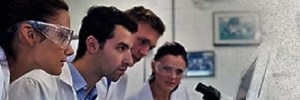Why is Testing for Coronavirus so hard?
The Short Answer
Useful and reliable diagnostic testing is a complex process requiring perfect completion of an unbroken chain of events:
- Grasp of the medical problem – what to test for, what to collect, and where and how to sample
- Accurate, timely and useful specimen collection methods
- Test components and collection supplies available for the right platform at the right locations in the right quantities at the right time
- Timely sample transport, accession and access to installed automated analytical equipment
- The ability to process, capture and report the results back to caregivers quickly
- All of the above at scale
Break the chain at any point and the effort fails. Further, our diagnostic testing systems must work at enormous scale, and scale-up brings its’s own daunting challenges.
A naval analogy may be useful here: “The fleet doesn’t sail any faster than the slowest ship”. A breakdown or bottleneck at any point, e.g., a shortage of the proper specimen collection swabs, brings the entire effort to a grinding halt.
It’s a hard and inconvenient truth, but adequate testing will still take some time if we want it to be widely available and correct. Wishing it was easier won’t make it so.
Is the FDA the problem?
The U.S. FDA regulatory process for medical diagnostics represents our collected experience on the ways that testing development, manufacture and use can run off the rails. Taking shortcuts means ignoring known likely failure points.
“Validating” all the components of the system informs the reliability of the results. Reliability of testing is literally a matter of life or death. The validation process can be accelerated with a concentration of effort and parallel evaluation of component parts, and that is being done.
Recent reports that up to 30% of coronavirus “negative” PCR test reports may be incorrect illustrates the risk of allowing urgency to overrule rigor. Failure of the initial CDC test kits further illustrates the point. Being wrong quickly is a danger all by itself. Trading speed for validated reliability introduces chaos, not confidence.
State vs. Federal
The U.S. Federal Government has regulatory jurisdiction over diagnostic testing equipment, devices and disposables with nationwide distribution. Both high-throughput automated “PCR” molecular tests for live virus, and “Antibody” blood tests for post-infection diagnosis (either point-of-care or high-throughput central laboratory versions) require review. Manufacturing quality standards are absolutely essential. All the test components and protocols must work individually and as a system. Bending the testing effort around automated high-throughput clinical diagnostic systems is the goal of a lot of current effort. We know how to do it, but we don’t know how to make it instantaneous.
Solutions to the testing challenge at national scale will be assisted and enabled by review systems under the jurisdiction of the FDA.
State governments have regulatory jurisdiction over clinical laboratories performing diagnostic testing in their geographies. State public health, hospital and academic testing laboratories fall in this group. State-licensed laboratories are permitted to conduct testing of “home-brew” tests under the supervision of a qualified clinical pathologist. Individual wet chemistry PCR coronavirus tests, for example, can be performed “under the hood” by trained laboratory technicians in state licensed “CLIA” laboratories. Rate limiting factors are quality-controlled reagents, trained technicians and laboratory facilities suitable for contagious pathogens. A significant proportion of initial COVID-19 testing was done this way. Reliability of local testing varies, and throughput rates are limited. It was never going to be the long-term answer, but it got things started.
Equipment
We go to war against COVID-19 with the diagnostic systems and hardware we have in place – what the commercial diagnostic equipment makers refer to as “the installed base”. The good news is that we have a lot of automated equipment, it is sophisticated, much of it is useful for this purpose, and we know how to use it. Reliable laboratory robotic systems ease the need for exposing technicians to the virus. Even so, there are limits to the throughput rates.
The bad news is that it is that there are several manufacturers of high-throughput analytical equipment. There is no single dominant national diagnostic equipment model. The equipment systems are not identical, not evenly distributed, and capacity-limited by the other systemic factors. Slight differences in reagents, disposable accessories, sample collection, accession and preparation protocols all impact progress by resisting standardization. Each testing moiety requires separate validation and quality control efforts. One size doesn’t fit all which magnifies supply chain and scale-up challenges.
Materials
Key among the materials necessary for testing are chemical or biochemical reagents – the “juice” that processes medical specimens. Manufacturing using standard biological products methods almost always involves trial-and-error. The “recipes” employ exacting process-intense manufacturing chemistry, highly technical “separations” technologies with their own materials requirements, and component testing for quality and stability at each step. The same is true for the plastic disposable components necessary to collect, prepare and process collected samples. Skip a step here with the critical inputs during “scale-up” and the whole house of cards collapses.
Proximity vs. Volume
The Abbott Labs system introduced in early April is designed for local testing and falls in a category known as Point-of-Care. The patient, physician and equipment are all at the same place. It is ideal for quick turn-around and immediately actionable information. The downside is that the platform can perform only one test at a time, manufacturing of disposable supplies is not yet at scale, and test material distribution logistics will be imperfect.
Central or “reference” laboratories can handle multiple tests simultaneously but take longer to produce results due to the intake, batching and reporting logistics. Reference laboratory testing is easier to scale, but test results are not immediately actionable. Here, too, the supply chain for disposable collection and testing materials has been imperfect.
The Path Forward
News of approval of for a test of the presence of the virus in saliva is a promising recent advance. Other clever approaches are certain to enter the testing armamentarium. Each advance, though, will still need to be thoroughly vetted and integrated into use. Our technology and logistics resources are enormous and up to the task, but each step in validation is still absolutely essential.
The fleet will get up to speed. We know how to do this. It will occur as quickly as possible. It just won’t be instantaneous.
Charles Grebenstein, Ph.D.
4/17/20





Leave a Reply
Want to join the discussion?Feel free to contribute!